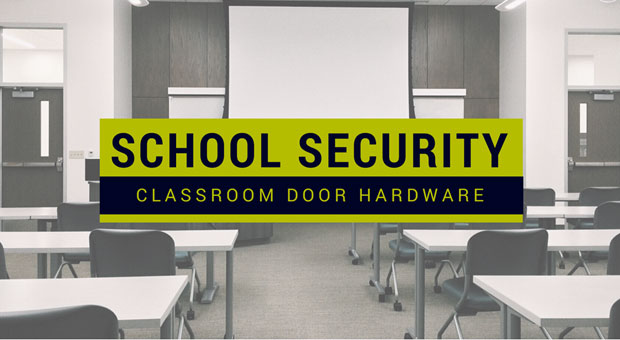When creating a plan for school security it is important to consider all of the layers, such as the perimeter of the building, entrances, classroom door locks, life safety codes, ADA requirements, and much more. At LaForce, we provide life safety and security solutions that building owners can easily understand, use, and afford, for both retrofit and new construction projects. We specialize in both mechanical door hardware and electronic access control options for classroom doors. In addition, our team has thorough knowledge of building codes and standards including IBC (International Building Code), IFC (International Fire Code), ICC/ANSI A117.1 (Accessible and Usable Buildings and Facilities), ADAAG (ADA Standards for Accessible Design), NFPA 101 (Life Safety Code), as well as other municipality-specific requirements.
Barricade Devices on Classroom Doors – Why They’re Wrong for Classroom Security
A barricade device is an additional device placed on a door, under a door, or over other door hardware (such as a hydraulic door closer arm) as a way to block the door from entry. These have become an appealing option for many school districts because they appear to be a fast and practical solution, but their use creates additional hazards. First of all, many of these devices have multiple steps for installation, which can be difficult and timely in an emergency and panic situation. Second, anyone can put these devices in place at any time, whether or not they should have the authority to do so. And third, many of the products provide a true barricade, meaning they can prevent emergency personnel from accessing the room.
Many states have already banned these devices because they do not comply with ADA requirements, life safety and fire codes. ADA Standards require door hardware to be operable with one hand and without tight grasping, pinching or twisting of the wrist, as well as be located no lower than 34” inches and no higher than 48” above the floor. Many classroom barricade devices do not comply with these requirements and could possibly lead to a discrimination suit. In addition, classroom barricades do not comply with life safety and fire codes which state that egress doors are required to be:
- Immediately operable without the use of a key
- Immediately operable without special knowledge or effort
- Operable by a single motion
Barricade devices can prohibit students and staff from quickly exiting the building in situations such as fires, explosions, gas leaks, or even an assailant entering through a window. These devices could also be used by a person with the intention to commit an assault or other serious crime by locking occupants within the classroom. When in place, these barriers would prevent school staff, law enforcement, and other emergency responders from entering the classroom, creating a liability risk for the school district.
Why Are Life Safety Codes Important?
Life safety codes were developed after several deadly fires occurred where occupants were prevented from exiting a building quickly. Specifically, in 1958 a fire broke out at Our Lady of the Angels parish, a K-8 Catholic school, resulting in 95 deaths (92 of these were students). There were multiple reasons why this fire was so devastating including the lack of fire alarms, heat detectors, fire doors, fire sprinklers, only having one fire escape, and that the school’s interior primarily contained highly combustible materials.
After the Our Lady of the Angels parish fire, the National Fire Protection Association (NFPA) rewrote its provisions for schools, completely revising the exit standards, which has resulted in zero school fires with more than ten deaths since 1958. These codes are just as important now as they were then. According to NFPA, between the years of 2011-2015, U.S. fire departments responded to an estimated average of 4,980 fires each year at educational properties. Classroom barricade devices violate the life safety codes by completely ignoring the important lessons from the past.
Recommended Code-Compliant Solutions
There are many code-compliant options available that allow for free egress, meet different budgets, and eliminate the need for a barricade device. Here are a just a few examples and price ranges:
Grade 1 Cylindrical Classroom Security Lock
- A cylindrical mechanical lockset.
- The key in either lever locks or unlocks the outside lever.
- The inside lever is always free for immediate egress out of the classroom.
- Opening the door via the inside lever does not change the outside status of the lock.
Grade 1 Mortise Classroom Security Lock
- A mortise mechanical lockset.
- The key used on either side of the door locks or unlocks the outside lever.
- The inside lever is always free for immediate egress out of the classroom.
- Opening the door via the inside lever does not change the outside status of the lock.
Wireless Electronic Classroom Lockdown Lock
- A mortise battery powered electronic lockset.
- The outside lever can be locked and unlocked using a proximity fob, or can be locked down by the teacher from across the room using a remote fob. Once the lock is put into lockdown mode, only the teacher’s remote fob, a mechanical key, or the administrator’s fob may unlock the outside lever.
- The inside lever is always free for immediate egress out of the classroom and does not change the outside status of the lock.
While the safety of students is a major concern all over the nation, reactions to school shootings should be thoughtful and calculated so as to not replace one danger with another. Years of research have gone into the creation of today’s building codes and LaForce does not condone the use of any type of device that would violate these codes and put the lives of children and teachers at risk. There are many classroom security options that are code-compliant and can provide exemplary security in an active shooter situation. Feel free to contact us for additional information on ADA or life safety codes and compliant door products.



Follow Us